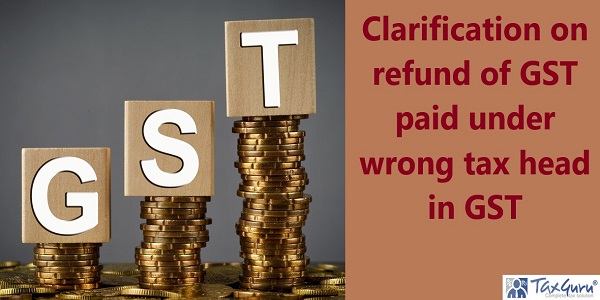GST has been a relatively new law for a large and diverse taxpayer base such as one in India and it is not quite a surprise that inadvertent errors are committed while complying with the provisions of law.
Once such error that the government was aware of and decided to bring into the multifold of law itself was the payment of tax under wrong tax head due to difference in interpretation of transaction i.e. a transaction reported as intra-state (subject to CGST and SGST/UTGST) subsequently identified as inter-state (subject to IGST) transaction and vice-a-versa.

1. Issue under consideration:
The taxpayers were seeking clarification from the CBIC on the interpretation of term – ‘subsequently held’ in Section 77 of the CGST Act, 2017 and corresponding Section 19 of the IGST Act, 2017.
Section 77 of CGST Act, 2017 reads as follows:
“Tax wrongfully collected and paid to Central Government or State Government. —
(1) A registered person who has paid the Central tax and State tax or, as the case may be, the Central tax and the Union territory tax on a transaction considered by him to be an intra-State supply, but which is subsequently held to be an inter-State supply, shall be refunded the amount of taxes so paid in such manner and subject to such conditions as may be prescribed.
(2) A registered person who has paid integrated tax on a transaction considered by him to be an inter-State supply, but which is subsequently held to be an intra-State supply, shall not be required to pay any interest on the amount of central tax and State tax or, as the case may be, the Central tax and the Union territory tax payable.”
Question raised by taxpayer: Whether refund is admissible under Section 77 (CGST Act, 2017) or Section 19 (IGST Act, 2017) even in situation wherein taxpayer itself has identified that a transaction which was earlier reported as intra-state is subsequently identified to be an inter-state transaction or vice-a-versa?
2. Clarification provided by CBIC:
Clarification provided by CBIC vide Circular No. 162/18/2021-GST Dated 25/09/2021
The term ‘subsequently held’ covers both of the following cases:
A. Inter-state supply made by a taxpayer is subsequently identified to be an intra-state transaction or vice-a-versa by the taxpayer itself.
B. Inter-state supply made by a taxpayer is subsequently identified to be an intra-state transaction or vice-a-versa by the tax officer in any proceeding.
Meaning of above clarification: The taxpayer will be eligible to claim refund in both the above cases provided the taxpayer has discharged the tax under the correct tax head.
3. Refund process prescribed in accordance with Section 77 of CGST Act, 2017:
To prescribe the manner of refund under Section 77 of CGST Act, 2017, the government has amended Rule 89 of CGST Rules, 2017 vide Notification No. 35/2021-Central Tax dated 24 September 2021, inserting Sub-rule 1A which prescribes the methodology for claiming refund under Section 77 as under:
- The refund claim to be filed through Form GST RFD-01.
- Time limit to file refund claim – Before expiry of 2 years from the date of payment of tax under correct tax head.
- Where tax payment under the correct tax head has already been made before the date of issuance of Notification No. 35/2021-Central Tax dated 24 September 2021 – Refund application can be filed before expiry of 2 years from the date of issuance of the notification under consideration i.e. before expiry of 2 years calculated from 24 September 2021.
4. Additional clarification:
- Any refund application filed in terms of Section 77 of CGST Act, 2017 before issuance of Notification No. 35/2021-Central Tax dated 24 September 2021, either pending or disposed off will be dealt in accordance with newly inserted Rule 89(1A) of CGST Rules, 2017.
- Refund will not be available wherein taxpayer has adjusted the tax wrongly charged through issuance of credit note.
The circular also cites 4 examples for better understanding of the clarification provided in the circular. However, the same are only indicative examples of the clarification provided.
*****
Disclaimer: The above article is based on the basis of author’s understanding and view on the tax laws, tax rules, the relevant circulars and notifications. Please refer to the latest law and consult the author before forming any opinion basis the information provided above as tax laws are subject to frequent changes. The author is not responsible for any issues arising as a result of opinion based on the above article without consultation. In any manner whatsoever, the views expressed in this article should not be construed as the views of the firm, the author is associated with. The author can be contacted on gauravmittal756@gmail.com.






Can I claim refund which is wrongly paid under Cess head.